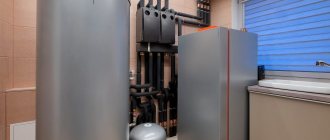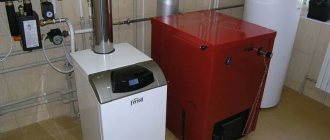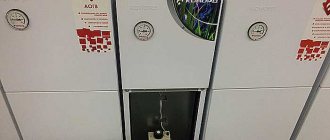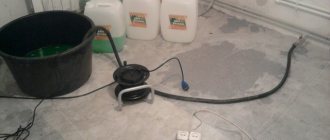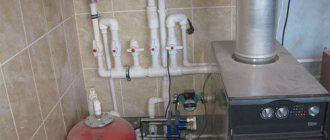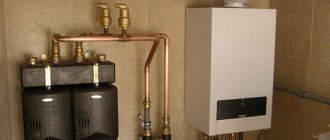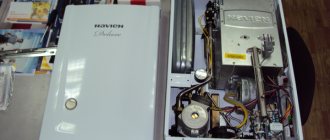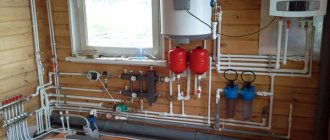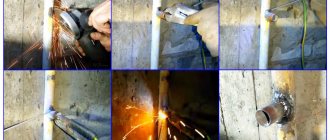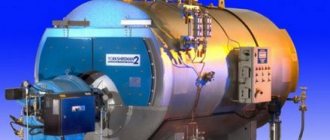Types of mounted boilers
Gas boilers are also available for traditional (conventional) and condensing boilers. Conventional ones are less efficient because they do not use all the energy contained in the burned fuel.
We are talking about water vapor, which is a product of gas combustion. In traditional devices it goes up the chimney.
- However, in condensing boilers it is compressed, so that the thermal energy contained in it can be recovered (hence, in their case, efficiencies of more than 100% are often found).
- Condenser models are a little more expensive than traditional ones, and they also require condensate to be drained from the boiler. However, in return we get a device that has an average efficiency 15% higher than that of a conventional boiler and consumes less gas.
Condensing boilers for low temperature heating systems
Having appeared relatively recently, “warm floor” systems are now becoming increasingly common as the main ones, especially in new houses and apartments with individual heating. They manage to implement them even on wooden joists, not to mention slab foundations, ground floors and concrete floors. The main difference between a heated floor and a radiator piping is not even the laying of the line in the screed, but the low temperature of the coolant and efficiency due to lower fuel consumption and high thermal inertia. Traditional gas boilers are used in such systems, but a condensing boiler will work more efficiently in it. It is characterized by increased efficiency due to the removal of thermal energy from flue gases, but in order for the equipment to function at full efficiency, the temperature in the “return” must be less than 55˚C. And these are just the parameters of warm floors or warm walls, but the latter are practically not found in our country.
In tandem with a heated floor, a condensing gas boiler will allow you to consume less gas, which is vitally important given the enviable stability of tariff growth. Condensing boilers also have one more undoubted advantage - the ability to operate at a power several times lower than the nominal one. Do not clock, switching on and off, but work in optimal mode.
SirazhudinForumHouse Member
I laid 70 square meters in my apartment. pipes for TP made of cross-linked polyethylene, 20-diameter, 5 circuits, about 400 m. In general, the next stage is choosing a boiler, since I only have a heated floor without radiators, I decided to buy a condensing type boiler. The store told me that they have a 400 sq.m. condensing boiler. So the question is, is it possible for me to install a boiler with such a reserve on my 70 sq. m. and will it work correctly?
Sergey BugaevProduct Specialist
It is better for you to pay attention to boilers of lower power; 24 kW will be enough. In general, gas condensing boilers have a higher modulation range, and they can easily operate in a small area even in spring and autumn. With a minimum power of 2.4 kW it will correspond to 24 kW.
The latest generation wall-mounted condensing boilers are characterized not only by efficiency and a large modulation range, but also by expanded functionality.
- Efficiency – up to 109.8%.
- Energy efficiency – A+.
- Weather-dependent regulation - maintains a constant temperature in the rooms, reducing or increasing power, depending on the ambient temperature.
- Built-in Wi-Fi module, remote control.
- Possibility of integration into a smart home control system.
Even the most reliable European equipment needs service in order for the boiler to be guaranteed; the installation must be trusted not just to professionals, but to certified installers. The process itself does not require any special manipulations, there is only one nuance.
polshinForumHouse Member
...Is the boiler piping and installation of the heating system of a condensing boiler very different from a conventional one?
Sergey BugaevProduct Specialist
There is only one difference: condensing boilers have condensate drained into the sewer system. This is a small tube through which condensate flows in a weak stream.
If we are talking about a private house with local treatment facilities, condensate in its pure form cannot be discharged into the sewer system. It must be pre-treated in a specialized neutralizer (a container with marble granules).
Combustion process
Gas heating appliances can have an open or closed combustion chamber. An open chamber boiler draws air to burn gas from the room in which it is installed, and the exhaust gases go up the chimney.
- Such a device requires a very efficient air exchange system. In this case, due to the risk of flue gases entering the room, only gravity ventilation is allowed (with mechanical ventilation, a fan can reverse the draft in the chimney and return the flue gas inside).
- For safety reasons, it is better to install boilers with an open combustion chamber not in the bathroom or kitchen, but in a separate boiler room or in a well-ventilated utility room.
- A little more expensive, but much safer - devices with a closed combustion chamber. Thanks to the built-in fan, they ensure the flow of necessary air from outside and the removal of exhaust gases there.
They work independently of the ventilation in the room - in this option there is no need to abandon the mechanical air exchange system. The closed combustion chamber in the boiler does not cause problems with cooling the interior, and devices equipped with it can be installed not only in the boiler room, but also in the hallway, kitchen or bathroom.
All currently produced boilers with a closed combustion chamber are condensing boilers.
In detached houses, when using a boiler with a closed combustion chamber with a power of up to 21 kW, the chimney installed above the roof can be replaced with a chimney running horizontally through the outer wall.
Features of gas heating
Heating buildings using gas infrastructure is the most popular in the world, although there are many alternatives to the tap - electricity, wood, coal, diesel, etc. This is not an accident; gas has the best price-performance ratio. Let's look at this nuance in more detail:
- Low price. Not only is gas itself relatively cheap, but gas system costs are low. Storage, supply maintenance, additional devices - all this is very beneficial for the consumer. Although some rare parts for boilers have to be found and overpaid. At the same time, the gas has a very high efficiency.
- Automated feeding. Gas does not need to be added to the boiler manually, like wood or coal. Human participation is kept to a minimum.
- Clean type of heating. Can be installed even in the kitchen; gas equipment does not produce soot, soot, or other debris.
- Great heating power. One boiler can be enough for several floors.
However, gas heating does not exist without specific disadvantages.
According to legal norms, a gas boiler can be installed at home only after agreement with Gaztekhnadzor. Not just anyone can carry out installation, but only special companies that have a license to provide such services.
Gas is explosive and flammable. Modern technology can detect its leak. Saving on installing automation is a big risk for the house and all residents.
A high-quality ventilation system is very important. Depending on its characteristics, the installation location of the boiler is selected. If, in any case, the draft to remove combustion products is not enough, then you have to install equipment to enhance it.
Single or double circuit boilers
According to the method of preparing hot water, gas boilers are divided into three groups:
- Single-circuit - heat water stored in a 100-200 liter tank. This means you need to find a place for the storage tank - in practice, this requires a separate boiler room. Thanks to the so-called circulation circuit, i.e. possibility of connecting several taps, hot water will circulate constantly. Such devices work well in large houses where there is hot water supply. collected at many points from the boiler;
- Double-circuit - they are a combination of a home heating boiler with an instantaneous water heater. They do not have a storage tank (so they take up less space) and they heat up hot water regularly, only when needed. Recommended primarily for buildings where all water intake points are located close to the boiler;
- Double function with tank - equipped with a small tank (eg 50L), they are a combination of the above two types. The boiler starts heating the DHW. only flow when the tank runs out. A circulation circuit can be connected to it.
Rating of the best manufacturers
Gas heating devices of foreign production are given absolute preference on the Russian market today. The leading positions are occupied by products of German, Italian and Czech companies.
So, the rating of manufacturing companies is presented as follows:
- German and Vaillant,
- Czech,
- Italian concern Ferroli.
Wolf boilers
Leader's wall-mounted gas boilers are high-quality and reliable products that are characterized by absolute ease of maintenance and operation. Wolf boilers operate on natural gas, while having the highest possible efficiency indicator, and are equipped with control system elements. This allows you to save fuel by being able to turn on the equipment when necessary. Among the Wolf models presented on the Russian market, computerized products occupy a special place. These are boilers of the “atmoMAX” and “turboMAX” series, the product range of which includes 17 models with a power rating of 12-28 kW.
Dakon boilers
Gas boilers "Dakon" are presented in models equipped with elements of modern automation. All Dakon devices comply with established international requirements and standards.
Ferroli boilers
Italian gas equipment is famous for its compactness and minimal dimensions, while meeting the highest requirements. The high quality inherent in the boilers is confirmed by the ISO 9002 certificate. Today, 8 series of Ferroli wall-mounted gas equipment are presented on the Russian market. Some models are characterized by the presence of an interface for connecting hot water and a built-in boiler.
Other foreign manufacturers
In addition, models from such Italian manufacturing companies as:
- “Ariston” (advantages include the ability to adapt to low pressure values, the presence of a connection to an outdoor sensor with a programming timer, the presence of filters for pre-cleaning, etc.),
- “Baxi” (among the advantages is the presence of a thermostat with a programming panel, weather-dependent automation, smooth electronic ignition, etc.),
- "Beretta" (among the advantages is the offer of models that are intended for areas with low average temperatures, under the NORD modification),
- “Lamborghini” (advantages include the ability to connect a programming console, adapt to low pressure, etc.).
The advantage of the products of these companies is that they are affordable at a high level of quality. Prices for wall-mounted gas boilers range from 22,000 to 35,000 rubles.
Domestic manufacturers of wall-mounted gas boilers
Domestic-made gas heating products are known, which are somewhat inferior to the characteristics of wall-mounted boilers from the above companies. Manufacturers are:
- "Signal",
- "Rostovgazoapparat"
- "Trade house Strela-Zvezda".
Gas boiler power
Although manufacturers tend to focus on this parameter, do not be discouraged when choosing a boiler from this angle. The power of the heating device must correspond to the actual heat demand. This parameter is indicated in the house design.
However, when modernizing a building, you cannot do without the help of a professional installer. In apartments and small houses, boilers with a capacity of 15-24 kW (in the case of single-circuit devices) and 17-27 kW (double-circuit models) are usually installed.
Choosing too much boiler power can lead to the fact that it will not be able to operate continuously and during transition periods (spring, autumn) it will wear out more quickly.
Boiler selection criteria
The boiler power is selected 30% higher than the design
power. The power of the device is the main characteristic that you should focus on when choosing equipment. It is indicated in the technical documentation. If you do not make accurate calculations, heating 10 m2 of space requires 1 kW. These values are very approximate. By default, the ceilings in the room should be no more than 3 m high, there is only one external wall - the one with the window.
The buyer should pay attention to the characteristics of the boiler, its additional functionality in the form of built-in control and safety systems, as well as the initial conditions in which the equipment will operate:
- presence of a chimney;
- the need to install a water boiler;
- quality of double-glazed windows and wall insulation;
- installation location;
- budget;
- climate zone;
- location of premises relative to cardinal directions.
All selection criteria are interrelated and interdependent.
With more accurate calculations, it usually turns out that the boiler power should be 20-30% higher. In addition, it is necessary to provide a power reserve in case of severe frosts of approximately 20%. If an indirect heating boiler is connected to the device, you need to add about 30%.
High power does not mean that gas consumption will be significant. This only means that the heated area will warm up faster. Fuel consumption will be approximately the same as when using less powerful models.
For rooms with an area of over 250 square meters, it is better to install a single-circuit boiler with a boiler.
Double-circuit boilers are more suitable for heating rooms of a relatively small area - up to 250 square meters. If the total heated area is larger, there is a risk that the equipment will not cope with its task. In this case, it is recommended to choose a single-circuit wall-mounted boiler and install an additional boiler to heat the water.
When purchasing a double-circuit boiler, you need to pay attention to the water heating performance. The liquid is heated by a flow method, so this characteristic is important. The manufacturer indicates the number of liters per minute when heating water by 25 or 35 degrees (Δt°). The following Δt° indicators are considered the norm for simultaneous operation of one or two water points:
- 25°C – 11 l/min;
- 35°C – 7-8 l/min.
In summer, cold water is much warmer, so there is no need to heat it much; in winter, heating should be more intense.
Number of heating elements in the system
Typically, the homeowner begins planning the heating system in the house by choosing the type of heating (radiator, floor) and the number of heating circuits themselves.
The main offer of mounted boilers on the market are low-temperature boilers with a simple design and automatic control for maintaining a constant temperature.
Their main application should be only standard installations with one circuit on radiators. In the case of a system with a large number of circuits (for example, additional heated floors), this type of boiler is not worth buying.
Typically, automatic weather control (specified for underfloor heating circuits) is already available in a series of condensing boilers, the optimal temperature of the heating water contributes to the achievement of high efficiency of these boilers.
- Dividing the heating system into separate circuits (for example, separating floor heating and radiators), among other things, increases the comfort of use. allowing separate control of temperature and heating time.
- On the other hand, mounted boilers that operate (as opposed to standing ones) as flow-through boilers require careful selection of the hydraulic system, and in the case of several circuits, additional circulation pumps, mixing valves and, often, a hydraulic coupling and automation are installed that interact with two or more circuits .
Specially designed boilers with increased water capacity are also available, operating similarly to floor-standing boilers. These types of boilers can operate without maximum flow limitation, even with three circulation pumps connected directly, without the use of a hydraulic coupling. They are therefore an ideal solution for multi-circuit heating systems.
Varieties based on operating principle
Gas wall-mounted boilers produced in recent years are complex devices, the efficiency of which designers are trying to increase in every possible way. There are two types of wall-mounted gas boilers, differing from each other in their operating principle.
Bithermal installations
In bithermal boilers, the heating and hot water circuits are different.
The design is represented by two metal tubes inserted into one another. DHW water flows through the inner, smaller diameter, and the outer circuit is intended for coolant used in the heating system. The peculiarity of such a device is that the external circuit heats the internal circuit.
Advantage: Fast heating.
Disadvantages: maximum fuel consumption, operation on excess thrust.
Pre-thermal units
In pre-thermal boilers, the heating circuits for DHW and heating fluid are separate and independent of each other. The tubes are usually copper, located on different sides of the body, and the liquids are heated separately.
Advantages: rational energy consumption, work on natural draft.
Disadvantages: slow heating, formation of limescale, need to use magnetic filters.

